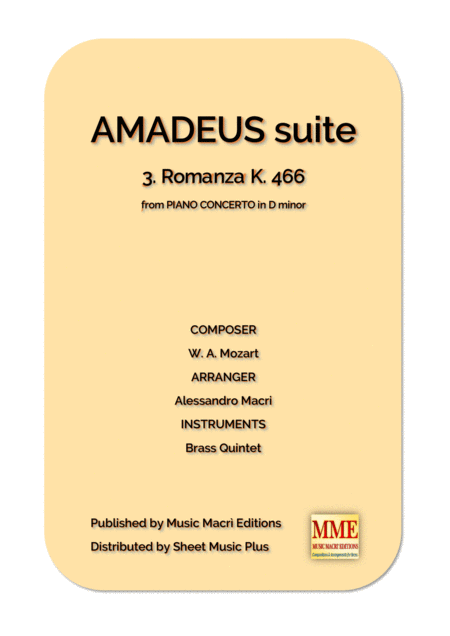Brass Ensemble Horn,Trombone,Trumpet,Tuba - Level 3 - Digital Download SKU: A0.931210 Composed by Wolfgang Amadeus Mozart. Arranged by Alessandro Macrì. Classical,Concert,Graduation. Score and parts. 20 pages. Music Macri Editions #3640387. Published by Music Macri Editions (A0.931210). Il concerto per pianoforte e orchestra n. 20, KV 466, è una composizione di Wolfgang Amadeus Mozart, completata il 10 febbraio1785 a Vienna.Wolfgang Amadeus Mozart finì di comporre il Concerto per pianoforte e orchestra n. 20 in re minore K 466 il 10 febbraio 1785. Il giorno successivo lo eseguì come solista a Vienna in uno dei suoi concerti per abbonamento che, a quel tempo, avevano molto richiamo. Narra la leggenda che Mozart distribuì agli orchestrali le copie appena trascritte dell'ultimo movimento, al momento stesso di andare in scena. Il concerto si svolse nella sala Mehlgrube e vi parteciparono anche il padre Leopold, appositamente venuto da Salisburgo.L'Andante del secondo tempo è una romanza in 2/2 in forma ABACA. Come fa spesso, qui Mozart gioca di contrasti, espliciti e mascherati. Il primo contrasto è con il carattere del movimento che lo ha preceduto. Nell'inizio del secondo movimento il tema è sereno, apparentemente idilliaco e la tonalità solare (Si bemolle maggiore) lo conferma. à il tempo scelto (2/2) che ci fornisce il primo indizio sulle intenzioni dell'autore. A differenza di altri pezzi di grande lirismo il tempo non è un morbido ternario (3/4, 6/8), né un 4/4 con il suo respiro ampio ed il suo alternarsi di battere forti e smussati, ma un marziale 2/2. Il tema principale viene esposto dal solista, ripreso poco dopo dall'orchestra, passa dall'una all'altro con la solita maestria orchestrale mozartiana. Il secondo tema si presenta immediatamente con un salto di ottava ed intervalli ampi si ritrovano in tutto il suo svolgimento. à questo espediente più volte iterato che Mozart usa per costruire tensioni armoniche in crescendo che portano al minore e ad atmosfere già distanti dal primo tema. Con grazia sorprendente Mozart torna quindi sul primo tema per la seconda sezione. La terza sezione tematica precipita in minore, e questa volta con una serie di scale forsennate che richiamano alcuni passaggi dello sviluppo del primo movimento. Gli accordi verticali in forte (bisognerà aspettare Beethoven per i primi fortissimo) marcano di brusche fermate e riprese il rincorrersi delle scale. Un arpeggio rallentato e un arabesco riportano al tema principale che chiude questa pagina in un finto clima di riconciliazione, aprendo al frenetico finale.
